
The Ellis Island Experience. Southpeak Interactive. CD-ROM, 2000. System Requirements: Windows 95/98, 133 MHz Pentium or other compatible processor, 32 MB RAM, 4X CD-ROM, 16 bit Windows Compatible Sound Card, Microsoft Compatible Mouse or other Pointing Device, (for connecting to Web site) 28.8K Modem, Internet Service Provider. CD-ROM linked to password-accessible Web site.
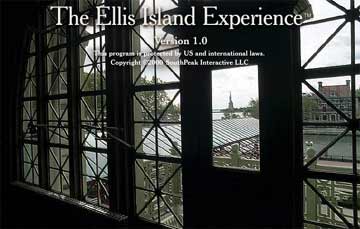 | |
One of the opening screens of The Ellis Island Experience. |
|
For about five years I have hopefully purchased CD-ROM instructional materials without ever ultimately requiring students to work with them in any of my classes. The Ellis Island Experience forced me to think about my reluctance. Like many CD-ROMs, it makes primary sources—especially (although not exclusively) audio-visual materials—wonderfully accessible to students and teachers alike. As I reviewed it, I often wished I could incorporate its audio-visual materials into the PowerPoint presentations I use to illustrate classroom lectures. (That is, of course, difficult.) Still, I probably would not assign it to students. Like many other CD-ROMs I've examined, The Ellis Island Experience imbeds its useful primary sources in a written text that is no substitute for either a good textbook, a reader, a series of lectures or a specialized monograph. It makes limited use of the interactive possibilities of CD-ROMs, and even less effective use of its attached Web site. I could imagine students using The Ellis Island Experience for a few research topics. It would be a useful addition to my college's reference collection. But in most cases I would recommend traditional print sources for classroom use.
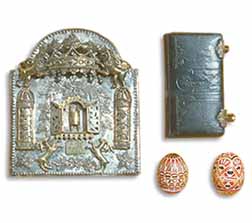 |
Heirlooms carried by immigrants.
From The Ellis Island Experience. |
|
The good news about The Ellis Island Experience is the diverse range of source materials it makes available. Its Gallery (located in the section titled The Golden Door) is probably its best feature. Here one finds photographs of material artifacts and of published and archival materials that can be viewed in great detail through an effective magnifier. Students can look at positive and negative images of immigrants from the late nineteenth and early twentieth centuries, examine passports and ships' manifests, and see immigrants' private possessions—shoes, an iron, an accordion—from the collection held at Ellis Island.
Scattered throughout the CD-ROM, and illustrating its thematic sections are transcripts and clips from oral history interviews (most of them with people who arrived in 1920s and 1930s). There are also five interactive docu-dramas that illustrate key bureaucratic moments experienced by all those who sought to enter the U.S. after 1890. Students can assume the role of a potential immigrant and respond to questions posed by American immigration officials in 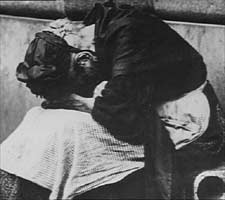 |
Examining an immigrant for disease. Disease
was one of many justifications for refusal
of entry. From The Ellis Island Experience.
28.8K | 56K | Cable/T1 |
|
Ireland and at Ellis Island, or take on the role of immigration inspectors completing the preliminary "six-second inspection" as new arrivals enter Ellis Island. Scattered throughout the CD-ROM are more than 30 video segments, narrated by National Public Radio's Robert Siegal. These have the somewhat fulsome tone of History Channel productions; the video material is engaging but sometimes presented in pastiches that utterly disregard time and place. Slide shows of photographs on particular topics are accompanied by background music that was surely intended to be inspiring but that I found annoying and repetitive. Interviews with "talking head" historians are mercifully few if also intelligent.
The biggest weakness of The Ellis Island Experience may originate in its creators' disdain for written texts as teaching tools. The CD-ROM "liner notes" admonishes prospective users, "Don't just read about history. Experience it...." Unsurprisingly, the written text that provides framework for the valuable primary sources in The Ellis Island Experience compares unfavorably to books I regularly assign my students, in part for the "experience" of reading them. First, there is a fundamental problem of concept that 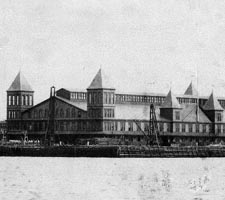 |
The evolution of Ellis Island. Photo: 1892.
Robert Siegel narrates a brief history.
From The Ellis Island Experience.
28.8K | 56K | Cable/T1 |
|
is most obvious in the written text. Is this the story of Ellis Island, the immigrants who passed through Ellis Island or of America as a nation of immigrants (whether they arrived through Ellis Island or not?) The Ellis Island Experience tries to offer a bit of all three, but only the first story emerges satisfactorily, in two strong sections on The Journey and on The Golden Door (which details the history of Ellis Island, and its restoration, and the bureaucracy of processing immigrants there). Compared to most texts in immigration history, this CD-ROM offers much greater, and welcome, detail about immigration as a form of human mobility. It follows migrants through the many steps of migration, and giving their reactions to leaving home, arriving in a port city, the sea voyage, the arrival in New York, the transfer to Ellis Island, the inspections undergone there, the end result of detention, deportation or release. These segments provide a rich mix of oral histories, primary sources, videos and docu-dramas.
To focus on Ellis Island is, of course, to focus on European immigrants (and to a much lesser degree, West Indians) between 1892 and 1954, yet many who invoke the image of Ellis Island wish it to symbolize the importance of immigration in American life more broadly. 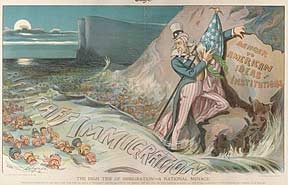 |
A cartoon illustrating nativist sentiments.
From The Ellis Island Experience. |
|
Thus, the first segment on The Old World focuses less on Ellis Island than on some of the immigrant groups that passed through it. Unfortunately, it depends much too heavily on a small number of oral histories and it provides a better introduction to migration from eastern than southern Europe, the Caribbean or Asia and Mexico. A later segment, Land of Dreams, treats the lives of immigrants in the U.S. in the early twentieth-century. It focuses almost exclusively on nativism and labor [28.8K | 56K | Cable/T1], with scarcely a nod to citizenship, politics, religion, education or family life. Its emphasis on the difficulties immigrants faced in adjusting to life in the U.S. is welcome antidote to more celebratory accounts. But even its discussion of labor seems hopelessly out of date in contrasting Jewish labor movement activists to disinterested and passive southern European workers.
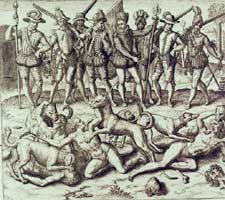 |
Spanish colonization of Mexico.
Print from 1598. From
The Ellis Island Experience. |
|
The final segment of The Ellis Island Experience, The Peopling of America is the most puzzling of its five segments. It strives to provide an ethnic history of the United States within the outlines of an immigration history timeline. It thus begins long before Ellis Island with the colonization of northern Mexico by the Spanish in 1598. Given this choice, it seems surprising that the timeline then ends in 1954, the year of Ellis Island's closing, and that it ends with a discussion of Brown vs. the Board of Education of Topeka, Kansas. The Ellis Island Experience provides a fairly complete overview of immigration restriction, so it is doubly confusing that it ignores the 1965 revision of restrictive immigration law. With no mention of the sizeable immigration that followed that revision, its account of The Peopling of America remains unfinished and inadequate.
The Ellis Island Experience could be useful to students wishing to write about European immigrant journeys at the turn of the century, about immigration law and restriction or about the history of the administration of American immigration bureaucracy. Unfortunately, the special features included to help students as researchers, and to make the CD-ROM useful for classroom assignments, are less than adequate. Students can easily cut and paste or download oral history texts. But the bibliography provided for their use will probably strike most experts in this field as too idiosyncratic to recommend (John Bodnar's book The Transplanted, is not included). The glossary included will also certainly be helpful to students, although it seems aimed at high school more than advanced college students (who typically enroll in Immigration History courses.) The search feature provided is not at all dependable. To test its robustness, I checked for references on Italy and on Italians. While it listed only seven references (mainly about the homeland), I found many more references to Italians than this in the audio-visual sources and textual materials.
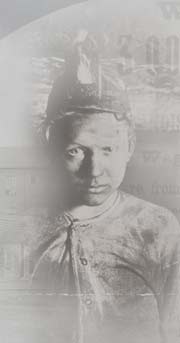 |
Background graphic. From
The Ellis Island Experience. |
|
The Ellis Island Experience provides users with access to a Web page that also proves to be of limited use, at least for the purposes of university teaching or undergraduate research. The most useful component of the Web page is a set of links to sites related to immigration history (e.g. The Balch Institute, the Center for Migration Studies, the Immigration History Research Center), to genealogy and to Ellis Island, its museum, the National Park Service, and the Ellis Island-Statue of Liberty Foundation. Of much smaller use are links to the consuls of some European nations that sent large numbers of emigrants to the U.S. (Italy, to give just one example, is not included). Students can also visit a store that offers a rather eclectic assortment of scholarly book titles and a rather full list of cookbooks on (mainly) European cuisines—but no scholarly studies of ethnic food. A small selection of wallpapers and screensavers are available for free down-loading although these come with the "Ellis Island Experience" logo prominently superimposed on them. Most of the Web page departments—Webcasts, genealogy, profile pages for Web page visitors, chat and forum rooms—are not yet mounted. Clicking on oral history delivers exactly two documents, one of them an oral history with Maria von Trapp. A potentially useful feature on contemporary immigration issues in the news has not been updated since June 2000. Apparently it will be quite some time before this Web page can provide students with the "community of immigration and genealogical enthusiasts" the producers promise in their promotional material.
Donna R. Gabaccia
University of North Carolina at Charlotte
~ End ~
CD-ROM Review of
The Ellis Island Experience
Copyright © 2000, 2001 by The Journal for MultiMedia History
Comments
| JMMH
Contents |






